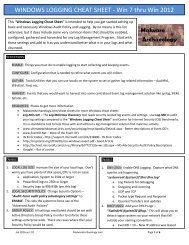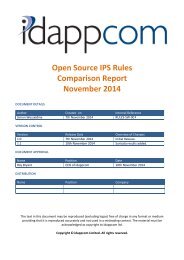The use of the Internet
The use of the Internet
The use of the Internet
Create successful ePaper yourself
Turn your PDF publications into a flip-book with our unique Google optimized e-Paper software.
12<br />
THE USE OF THE INTERNET FOR TERRORIST PURPOSES<br />
may bear <strong>the</strong> characteristics <strong>of</strong> an act <strong>of</strong> terrorism, including <strong>the</strong> fundamental desire<br />
to instil fear in fur<strong>the</strong>rance <strong>of</strong> political or social objectives. An example <strong>of</strong> a cyberattack<br />
was seen in Israel in January 2012, involving <strong>the</strong> targeting <strong>of</strong> multiple symbolic Israeli<br />
websites, such as <strong>the</strong> websites <strong>of</strong> <strong>the</strong> Tel Aviv Stock Exchange and <strong>the</strong> national airline,<br />
and <strong>the</strong> unauthorized disclosure <strong>of</strong> <strong>the</strong> credit card and account details <strong>of</strong> thousands <strong>of</strong><br />
Israeli nationals. 19 While a considerable amount <strong>of</strong> attention has foc<strong>use</strong>d in recent years<br />
on <strong>the</strong> threat <strong>of</strong> cyberattacks by terrorists, that topic is beyond <strong>the</strong> scope <strong>of</strong> <strong>the</strong> present<br />
publication and, as such, will not be a subject <strong>of</strong> analysis.<br />
C. Uses <strong>of</strong> <strong>the</strong> <strong>Internet</strong> for countering terrorist activity<br />
29. While terrorists have developed many ways to <strong>use</strong> <strong>the</strong> <strong>Internet</strong> in fur<strong>the</strong>rance <strong>of</strong><br />
illicit purposes, <strong>the</strong>ir <strong>use</strong> <strong>of</strong> <strong>the</strong> <strong>Internet</strong> also provides opportunities for <strong>the</strong> ga<strong>the</strong>ring<br />
<strong>of</strong> intelligence and o<strong>the</strong>r activities to prevent and counter acts <strong>of</strong> terrorism, as well as<br />
for <strong>the</strong> ga<strong>the</strong>ring <strong>of</strong> evidence for <strong>the</strong> prosecution <strong>of</strong> such acts. A significant amount <strong>of</strong><br />
knowledge about <strong>the</strong> functioning, activities and sometimes <strong>the</strong> targets <strong>of</strong> terrorist organizations<br />
is derived from website, chat room and o<strong>the</strong>r <strong>Internet</strong> communications. Fur<strong>the</strong>r,<br />
increased <strong>Internet</strong> <strong>use</strong> for terrorist purposes provides a corresponding increase in <strong>the</strong><br />
availability <strong>of</strong> electronic data which may be compiled and analysed for counter-terrorism<br />
purposes. Law enforcement, intelligence and o<strong>the</strong>r authorities are developing increasingly<br />
sophisticated tools to proactively prevent, detect and deter terrorist activity involving<br />
<strong>use</strong> <strong>of</strong> <strong>the</strong> <strong>Internet</strong>. <strong>The</strong> <strong>use</strong> <strong>of</strong> traditional investigative means, such as dedicated<br />
translation resources for <strong>the</strong> timely identification <strong>of</strong> potential terrorist threats, is also<br />
expanding.<br />
30. Online discussions provide an opportunity to present opposing viewpoints or to<br />
engage in constructive debate, which may have <strong>the</strong> effect <strong>of</strong> discouraging potential supporters.<br />
Counter-narratives with a strong factual foundation may be conveyed through<br />
online discussion forums, images and videos. Successful messages may also demonstrate<br />
empathy with <strong>the</strong> underlying issues that contribute to radicalization, such as political<br />
and social conditions, and highlight alternatives to violent means <strong>of</strong> achieving <strong>the</strong> desired<br />
outcomes. 20 Strategic communications that provide counter-narratives to terrorist propaganda<br />
may also be disseminated via <strong>the</strong> <strong>Internet</strong>, in multiple languages, to reach a<br />
broad, geographically diverse audience.<br />
31. <strong>The</strong> Center for Strategic Counterterrorism Communications, based in <strong>the</strong> United<br />
States, <strong>of</strong>fers an example <strong>of</strong> a recently launched inter-agency initiative which is aimed<br />
at reducing radicalization and extremist violence by identifying in a timely manner<br />
extremist propaganda, inter alia, on <strong>the</strong> <strong>Internet</strong> and responding swiftly with targeted<br />
19 See Isabel Kershner, “Cyberattack exposes 20,000 Israeli credit card numbers and details about <strong>use</strong>rs”, New York<br />
Times, 6 January 2012; and “2 Israeli web sites crippled as cyberwar escalates”, New York Times, 16 January 2012.<br />
20 Counter-Terrorism Implementation Task Force Working Group on Use <strong>of</strong> <strong>the</strong> <strong>Internet</strong> for Terrorist Purposes,<br />
“Conference summary and follow-up/recommendations” <strong>of</strong> <strong>the</strong> Conference on <strong>the</strong> Use <strong>of</strong> <strong>the</strong> <strong>Internet</strong> to Counter <strong>the</strong><br />
Appeal <strong>of</strong> Extremist Violence, held in Riyadh from 24 to 26 January 2011. Available from www.un.org/en/terrorism/<br />
ctitf/pdfs/ctitf_riyadh_conference_summary_recommendations.pdf.







